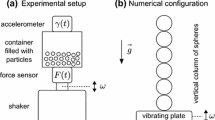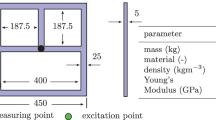Abstract
Particle damping is a non linear type of damping in which energy of the vibratory system is dissipated by the impact and the frictional losses made by the particles used for the damping purposes. The particle damping technique is useful over other types of damping as it is temperature independent. So it is reliable over wide temperature range and hence is essentially used in the cryogenic and the gas turbine related applications. For experimentation, cantilever beam with particle enclosure attached to its free end has been extensively used and the effect of the particle material, particle size, mass ratio and enclosure height on the damping performance has been studied [1]. For a small weight penalty, rather large amounts of damping can be achieved [2].





Similar content being viewed by others
Abbreviations
- M :
-
Primary mass of the system (Kg)
- K :
-
Equivalent stiffness of the system (N/m)
- V i :
-
Peak velocity of the ith cycle (m/s)
- Ψ :
-
Specific damping capacity factor
- Ψ max :
-
Maximum Specific damping capacity factor
- Γ :
-
Dimensionless acceleration amplitude
- µ :
-
Mass ratio
- ξ eq :
-
Equivalent viscous damping factor
- C eq :
-
Equivalent viscous damping coefficient (Ns/m)
References
K.S. Marhadi, Particle Impact Damping: Influence of Material and Size (Texas A&M University, College Station, Texas, 2005)
V.K. Kinra, B. Witt Investigating Particle Impact Damping as a Means of Fatigue Reduction (Texas A&M University, College Station, Texas)
Kuanmin Mao, Yu. Michael, Zhiwei Xu Wang, Tianning Chen, Simulation and characterization of particle damping in transient vibrations. ASME J. Vib. Acoust. 126, 202–211 (2004)
M.R. Duncan, C.R. Wassgren, C.M. Krousgrill, The damping performance of a single particle impact damper. J. Sound Vib. 286, 123–144 (2005)
M. Saeki, Analytical study of multi-particle damping. J. Sound Vib. 281, 1133–1144 (2005)
S.E. Olson, An analytical particle damping model. J. Sound Vib. 264, 1155–1166 (2003)
Author information
Authors and Affiliations
Corresponding author
Rights and permissions
About this article
Cite this article
Chavan, S.P., Kale, A. & Mulla, F.A. Experimental Investigation of the Damping Behavior of the Particle Damping in the Transient Vibrations. J. Inst. Eng. India Ser. C 97, 25–31 (2016). https://doi.org/10.1007/s40032-015-0194-9
Received:
Accepted:
Published:
Issue Date:
DOI: https://doi.org/10.1007/s40032-015-0194-9




